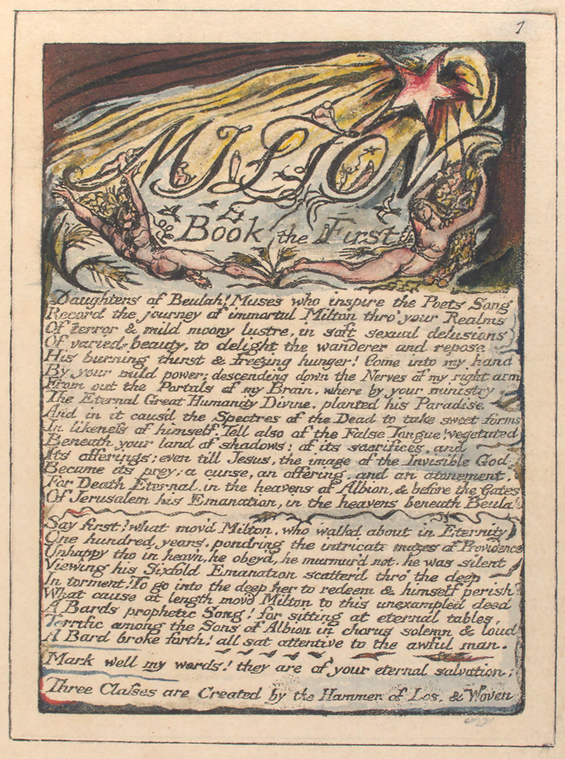Milton's double poem L'Allegro and Il Penseroso was the work
of a young man not the reflection of an old one. It was one of his
early works in English written about 1634 when he was about 25 years
old. His experience of the joyous, extroverted mood may have come
from his associations with friends and encounters with the theater
and concerts as entertainment. From his early childhood much of his
time had been spent on the more solitary pursuits of studying
language and literature. Although he had completed his studies at
Cambridge, he was at this stage of his life undecided on a career.
The young man who wrote L'Allegro and Il Penseroso seems to
have desired to incorporate the joyful, light-heartedness of mirth
and the reflective, seriousness of melancholy in his life whatever
career he followed. Continuing to write poetry was something he
acutely desired.
Blake began illustrating Milton's poetry in 1801 with a commission from Rev. Joseph Thomas to illustrate Comus, another of Milton's early works. Blake's final set of illustrations to Milton's works was to L'Allegro and Il Penseroso done for his loyal supporter Thomas Butts sometime after 1816 when he was over 60 years old. Milton wrote when he was looking forward to his own life; Blake illustrated looking back on Milton's life and work and his own. Blake had written his poem Milton between 1803 and 1810 to record the return of Milton to the land he had left a century and a quarter earlier.
Blake began illustrating Milton's poetry in 1801 with a commission from Rev. Joseph Thomas to illustrate Comus, another of Milton's early works. Blake's final set of illustrations to Milton's works was to L'Allegro and Il Penseroso done for his loyal supporter Thomas Butts sometime after 1816 when he was over 60 years old. Milton wrote when he was looking forward to his own life; Blake illustrated looking back on Milton's life and work and his own. Blake had written his poem Milton between 1803 and 1810 to record the return of Milton to the land he had left a century and a quarter earlier.
Milton, Plate 2, (E 96)
"Daughters of Beulah! Muses who inspire the Poets Song
Record the journey of immortal Milton thro' your Realms
Of terror & mild moony lustre, in soft sexual delusions
Of varied beauty, to delight the wanderer and repose
His burning thirst & freezing hunger! Come into my hand
By your mild power; descending down the Nerves of my right arm
From out the Portals of my Brain, where by your ministry
The Eternal Great Humanity Divine. planted his Paradise,
And in it caus'd the Spectres of the Dead to take sweet forms
In likeness of himself. Tell also of the False Tongue! vegetated
Beneath your land of shadows: of its sacrifices. and
Its offerings; even till Jesus, the image of the Invisible God
Became its prey; a curec, an offering, and an atonement,
For Death Eternal in the heavens of Albion, & before the Gates
Of Jerusalem his Emanation, in the heavens beneath Beulah
Say first! what mov'd Milton, who walkd about in Eternity
One hundred years, pondring the intricate mazes of Providence
Unhappy tho in heav'n, he obey'd, he murmur'd not. he was silent
Viewing his Sixfold Emanation scatter'd thro' the deep
In torment! To go into the deep her to redeem & himself perish?
What cause at length mov'd Milton to this unexampled deed[?]
A Bards prophetic Song! for sitting at eternal tables,
Terrific among the Sons of Albion in chorus solemn & loud
A Bard broke forth! all sat attentive to the awful man."
Kay and Roger Easson introduce their commentary to Blake's poem in their book Milton, a Poem by William Blake with these insightful words:
"To read William Blake''s illuminated books is to participate in a spiritual education. To read Blake's Milton is to discover the nature of that spiritual education concurrently with the education itself. Consequently, Blake's Milton does not exist solely as an object of admiration or study. Although Milton is incredibly beautiful in its combination of word and illustration and although its complexity stimulates intellectual scrutiny, it is a prophecy and, like all prophecy, it provides spiritual instruction. William Blake is a spiritual teacher, a prophet who, having 'discover'd the infinite in every thing' is committed to 'raising other men into a perception of the infinite' (The Marriage of Heaven and Hell). And, Milton is the book in which Blake teaches how 'all the Lord's people' can become prophets. In Milton Blake defines the spiritual journey which renews prophecy in every moment of human time." (Page 135)
The images provided in the illustrations to L'Allegro and Il Peneroso should be viewed as an extension of Blake's prophetic teachings in Milton.
.


No comments:
Post a Comment